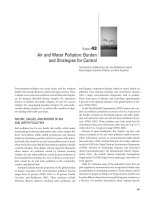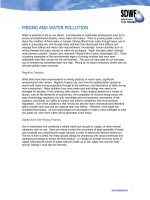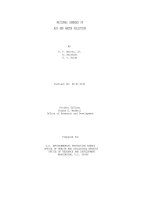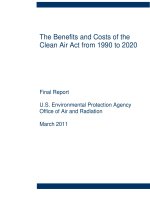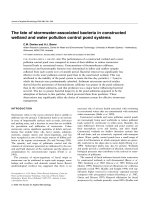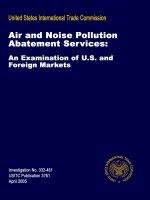AOS 104 Fundamentals of Air and Water Pollution docx
Bạn đang xem bản rút gọn của tài liệu. Xem và tải ngay bản đầy đủ của tài liệu tại đây (944.39 KB, 15 trang )
AOS 104
Fundamentals of Air
and Water Pollution
Dr. Jeffrey Lew
AIM: jklew888
MS1961
310-825-3023
TuTh 2:00-3:20
PAB 1-434A
Grades
Homework
150 pts
2 Midterms
300 pts
Final Exam
550 pts
Total
1000 pts
Homework
•
There will be 6 homework sets
•
Homework is due by the end of
business (~ 5 pm) on the due date
•
Late homework will receive partial
credit as outlined in the syllabus
•
You are encouraged to work together
and discuss approaches to solving
problems, but must turn in your own
work
1
2
3
Lecture Notes
Topics of the course
•
Calculating pollution concentration
•
Effects of pollution on acidity (pH)—acid rain
•
Types of water pollution
➔
Health effects from water pollution
•
Types of air pollution
➔
Health effects of air pollution
•
Urban air pollution—bad ozone
•
Stratospheric air pollution—depletion of
good ozone
•
Global climate change
Introduction
•
Measurement of Concentration
➔
Liquids
➔
Air
➔
Conversions Involving the Ideal Gas Law
•
Material Balance Models
➔
Basics
➔
Steady-state Model With Conservative
Pollutants
➔
Residence Time
➔
Steady and Non-steady Models With Non-
conservative Pollutants
4
5
6
Units of Measurement
•
Both SI and British units used
➔
Be able to convert between these two
standards
➔
Examples
Quantity
SI
British
Length
m
ft
Volume
m
3
ft
3
Power
watt
BTU/hr
Density
kg/m
3
lb/ft
3
Concentration
•
The amount of a specified substance
in a unit amount of another substance
➔
Usually, the amount of a substance
dissolved in water or mixed with the
atmosphere
•
Can be expressed as
Mass/Mass
g/kg, lb/ton, ppmm, ppbm
Mass/Volume
g/L, µg/m
3
Volume/Volume
mL/L, ppmv, ppbv
Volume/Mass
L/kg
Moles/Volume
molarity, M, mol/L
Liquids
Concentrations of substances dissolved in
water are generally given as mass per unit
volume.
e.g., milligrams/liter (mg/L) or micrograms/
liter (µg/L)
Concentrations may also be expressed as a
mass ratio, for example:
7 mass units of substance A per million
mass units of substance B is 7 ppmm.
7
8
9
Example 1
23 µg of sodium bicarbonate are added to 3
liters of water.
What is the concentration in µg/L and in ppb
(parts per billion) and in moles/L?
To find the concentration in ppb we need the
weight of the water.
= 7.7
µg
L
23 µg
3 L
Standard assumption: density of water is
1g/ml or 1000 g/L (at 4°C).
7.7 × 10
−6
g
1 L
×
1 L
1000 g
= 7.7 × 10
−9
=
7.7
10
9
=
7.7
billion
= 7.7 ppbm
➭ For density of water is 1000 g/L,
1 μg/L = 1 ppbm
1 mg/L = 1 ppmm
Sometimes, liquid concentrations are
expressed as mole/L (M).
e.g., concentration of sodium bicarbonate
(NaHCO
3
) is 7.7 µg/L
Molar Concentration =
7.7
µ
g
1 L
×
1 mol
84 g
×
1 g
1 × 10
6
µ
g
= 9.2 × 10
−8
mol
L
Molecular Weight = 23 + 1 + 12 + (3 × 16)
[ ]
g
mol
= 84
g
mol
10
11
12
Air
Gaseous pollutants—use volume ratios:
ppmv, ppbv
Or, mass/volume concentrations—use m
3
for volume
Example 2
A car is running in a closed garage. Over 3
minutes, it expels 85 L of CO. The garage
is 6 m × 5 m × 4 m. What is the resulting
concentration of CO? Assume that the
temperature in the room is 25°C.
Solution:
The volume of CO is 85 L and
Volume of room = 6 m × 5 m × 4 m
= 120 m
3
= 120000 L
Concentration =
85 L
120000 L
= 0.000708 = 708 × 10
−6
= 708 ppmv
Example 2 Cont.
Instead of 85 L of CO, let’s say 3 moles of CO
were emitted.
We need to find the volume occupied by three
moles of CO.
IDEAL GAS LAW: PV= nRT
P = Pressure (atm)
V = Volume (L)
n = Number of moles
R = Ideal Gas Constant = 0.08206 L·atm·K
–1
·mol
–1
T = Temperature (K)
13
14
15
This law tells you how a gas responds to a
change in its physical conditions. Change P,
V or T, and the others adjust
To remember the units it’s
All Lovers Must Kiss
(atm, L, mol, K)
The Ideal Gas Law
Can rearrange to get the equality,
etc.so
P
1
V
1
= nRT
1
P
2
V
2
= nRT
2
P
1
V
1
T
1
= nR =
P
2
V
2
T
2
PV = nRT
The ideal gas law also tells you that:
‣
at 0°C (273 K) and 1 atm (STP),
1 mole occupies 22.4 L
‣
at 25°C (298 K) (about room temperature)
and 1 atm,
1 mole occupies 24.5 L
16
17
18
Back to Example 2
Volume of CO = 3 mol
( )
24.5
L
mol
⎛
⎝
⎜
⎞
⎠
⎟
= 73.5 L
Volume of room = 6 m × 5 m × 4 m
= 120 m
3
= 120000 L
Concentration =
73.5 L
120000 L
= 0.000613
= 613 × 10
−6
= 613 ppmv
Material Balances
•
Expresses Law of Conservation of
Mass
•
Material balances can be applied to
many systems—organic, inorganic,
steady-state, financial, etc.
Basic equation of material balance
Input = Output – Decay + Accumulation
(eq. 1.11)
Input, output, etc. are usually given as rates,
but may also be quantities (i.e. masses).
➡
This equation may be written for the overall
system, or a series of equations may be
written for each component and the equations
solved simultaneously.
Steady-state (or equilibrium), conservative
systems are the simplest
➡
Accumulation rate = 0, decay rate = 0
19
20
21
Example 3
Problem 1.7 – Agricultural discharge
containing 2000 mg/L of salt is released into a
river that already has 400 ppm of salt. A town
downstream needs water with <500 ppm of
salt to drink. How much clean water do they
need to add?
Maximum recommended level of salts for
drinking water = 500 ppm.
Brackish waters have > 1500 ppm salts.
Saline waters have > 5000 ppm salts.
Sea water has 30,000–34,000 ppm salts.
What is the concentration in flow Q?
What flow of clean water (R) must be
mixed to achieve 500 ppm?
(What is the ratio of R/S?)
25.0 m
3
/s
400 ppm
5.0 m
3
/s
2000 mg/L
Q m
3
/s
C ppm
S+R m
3
/s
500 ppm
R m
3
/s
0 ppm
S m
3
/s
C ppm
To simplify, we can break this into two
systems—first (remembering that 1 ppmm
= 1 mg/L)
25.0 m
3
/s
400 ppm
5.0 m
3
/s
2000 mg/L
Q m
3
/s
x ppm
Basic equation: input = output
Thus, C = the salt concentration at the take-
out from the river = 667 ppmm
Q = Total flow = 25.0
m
3
s
+ 5.0
m
3
s
= 30.0
m
3
s
25.0
m
3
s
× 400 ppmm
( )
+ 5.0
m
3
s
× 2000 ppmm
( )
= Q
m
3
s
× C ppmm
( )
22
23
24
Solve the other part of the system:
S m
3
/s
667 ppm
S+R m
3
/s
500 ppm
R m
3
/s
0 ppm
667S = 500S + 500R
R
S
=
667 − 500
500
= 0.33
S
m
3
s
× 667 ppmm
⎡
⎣
⎤
⎦
+ R
m
3
s
× 0 ppmm
⎡
⎣
⎤
⎦
= S + R
( )
m
3
s
× 500 ppmm
•
Lifetime or residence time of substance
≡ amount / rate of consumption
•
Lifetime of Earth’s petroleum resources:
1.0 x 10
22
J / 1.35 x 10
20
J/yr = 74 years
Residence Time
ANWR has ~5.7 to 16.3 × 10
9
barrels of oil; best guess is
10 ×10
9
. The US consumes 19 million barrels/day of oil.
How much time does this give us?
•
The residence time may be defined for a
system in steady-state as:
•
Residence time in a lake: The average time
water spends in the lake
•
Some water may spend years in the lake
•
Some may flow through in a few days
➡
Depends on mixing.
Stock (material in system)
Flow rate (in or out)
25
26
27
For this very simple steady state system, we
calculate the residence time
Ex. The volume of a lake fed by a stream
flowing at 7 × 10
5
m
3
/day is 3 × 10
8
m
3
. What
is the residence time of the water in the
lake?
•
In the first approximation, consider only
stream flow in and stream flow out.
T = M/F
in
= M/F
out
3 × 10
8
m
3
7 × 10
5
m
3
day
= 430 days
More Material Balances
•
What if a substance is removed by
chemical, biological or nuclear
processes?
➔
The material is still in steady-state if its
concentration is not changing.
•
Steady-state for a non-conservative
pollutant:
➔
We now need to include the decay rate in
our material balance expression:
Input rate = Output rate + Decay rate
where k = reaction rate coefficient, in
units of 1/time.
C = concentration of pollutant
Separate variables and integrate:
Assume decay is proportional to
concentration (“1
st
order decay”).
dC
dt
= −kC
dC
C
C
0
C
∫
= −k dt
0
t
∫
28
29
30
Take the exponential of each side:
For a particular system (i.e., a lake), we can write a
total mass decay rate (mass/time), that we can
compare with the input and output rates:
= kCV ⇒ mass removal rate
k has units of 1/time
C has units of mass/volume
V has units of volume
Thus the decay rate = kCV (mass/time)
ln C
( )
− ln C
0
( )
= −kt − kt
0
Solution:
C = C
0
e
−kt
ln C
( )
− ln C
0
( )
= ln
C
C
0
⎛
⎝
⎜
⎞
⎠
⎟
= −kt
Steady state with decay
Input rate = Output rate + kCV
Example 4
A lake with a constant volume of 10
7
m
3
is fed
by a clean stream at a flow of 50 m
3
/s. A
factory dumps 5.0 m
3
/s of a non-conservative
pollutant with a concentration of 100 mg/L into
the lake. The pollutant has a reaction (decay)
rate coefficient of 0.4/day (= 4.6 × 10
–6
s
–1
).
Find the steady-state concentration of the
pollutant in the lake.
Material Balance
Equation
5 m
3
/s
100 mg/L
50 m
3
/s
0 mg/L
10
7
m
3
???
K= 0.4 /day = 4.6 × 10
–6
s
–1
Solution:
Assume the volume of the lake is constant,
so the outflow is equal to the inflow, or
Water outflow rate = 55 m
3
/s
For the pollutant:
Input rate = Output rate + Decay rate
Start by drawing a diagram of the problem
statement.
31
32
33
Accumulation rate = Input rate
– Output rate
– Decay rate
V
dC
dt
= S − QC − kCV
Variation—Non-steady situation
Consider a lake that initially had zero
concentration of the pollutant, and then a
pollutant was introduced. How is the
concentration changing with time? (i.e., a
transient phenomenon—not steady-state)
☞ Step function response
Mass balance:
Eventually system reaches a steady-state
concentration, C(∞) (i.e., when dC/dt = 0)
Concentration as a function of time (before
steady-state is reached) is given by the
transient equation:
dC
dt
=
S
V
−
QC
V
− kC
C ∞
( )
= C
∞
=
S
Q + kV
which can be rearranged to give:
So we can substitute for C
∞
:
dC
dt
= − k +
Q
V
⎛
⎝
⎜
⎞
⎠
⎟
C −
S
Q + kV
⎡
⎣
⎢
⎤
⎦
⎥
dC
dt
= − k +
Q
V
⎛
⎝
⎜
⎞
⎠
⎟
C − C
∞
[ ]
y = C − C
∞
⇒
dy
dt
=
dC
dt
To integrate, we simply the C – C
∞
term:
34
35
36
➯ a familiar, separable differential equation
(k+Q/V is a constant!), with a solution of the
form:
Substituting and rearranging,
At t = 0, exp = 1
t = ∞, exp = 0
dy
dt
= − k +
Q
V
⎛
⎝
⎜
⎞
⎠
⎟
y
y = y
0
e
− k +
Q
V
⎛
⎝
⎜
⎞
⎠
⎟
t
where y
0
= C
o
− C
∞
C t
( )
= C
∞
+ C
0
− C
∞
( )
exp − k +
Q
V
⎛
⎝
⎜
⎞
⎠
⎟
t
⎡
⎣
⎢
⎤
⎦
⎥
Concentration
Time
C
0
C
∞
What is the general behavior of this equation?
At time = 0, the exponential term goes to 1 so
C = C(0)
At time = ∞ , exp goes to 0 ⇒ C = C
∞
C t
( )
= C
∞
+ C
0
− C
∞
( )
exp − k +
Q
V
⎛
⎝
⎜
⎞
⎠
⎟
t
⎡
⎣
⎢
⎤
⎦
⎥
Example 5
Bar with volume of 500 m
3
Fresh air enters at a rate of 1000 m
3
/hr
Bar is clean when it opens at 5 PM
Formaldehyde is emitted at 140 mg/hr after
5 PM by smokers
k = the formaldehyde removal rate coeff. =
0.40/hr
What is the concentration at 6 PM?
Solution—First we need C
∞
C t
( )
= C 0
( )
− C
∞
( )
exp − k +
Q
V
⎛
⎝
⎜
⎞
⎠
⎟
t
⎡
⎣
⎢
⎤
⎦
⎥
+ C
∞
37
38
39
For the concentration at 6 PM, one hour after
the bar opens, substitute known values into:
Q = 1000 m
3
/hr; V = 500 m
3
; S=140 mg/hr;
k = 0.40 /hr
C
∞
=
S
Q + kV
=
140.0 mg/hr
1000.0 m
3
/hr + 0.4/hr × 500 m
3
( )
C
∞
= 0.117 mg/m
3
C t
( )
= C
0
− C
∞
( )
exp − k +
Q
V
⎛
⎝
⎜
⎞
⎠
⎟
t
⎡
⎣
⎢
⎤
⎦
⎥
+ C
∞
C t
( )
= 0 − 0.117
mg
m
3
⎛
⎝
⎜
⎞
⎠
⎟
exp − 0.40
1
hr
+
1000.0
m
3
hr
500.0m
3
⎛
⎝
⎜
⎜
⎜
⎞
⎠
⎟
⎟
⎟
t
⎡
⎣
⎢
⎢
⎢
⎢
⎤
⎦
⎥
⎥
⎥
⎥
+ 0.117
mg
m
3
C t
( )
= 0.117
mg
m
3
1 − e
−2.4t
( )
C 1 hr
( )
= 0.117
mg
m
3
1 − e
−2.4
( )
= 0.106 mg/m
3
5 m
3
/s
100 mg/L
50 m
3
/s
0 mg/L
10
7
m
3
1 m
3
/s
42 mg/L
Pollutant B
k = 0.4 /day
???
New factory opens, discharging pollutant B.
If k is 0.4/day, what is the concentration
after 2 days of discharges?
S = 1
m
3
s
⎛
⎝
⎜
⎞
⎠
⎟
1000
L
m
3
⎛
⎝
⎜
⎞
⎠
⎟
86400
s
day
⎛
⎝
⎜
⎞
⎠
⎟
42
mg
L
⎛
⎝
⎜
⎞
⎠
⎟
= 3.628 × 10
9
mg
day
Q = 50 + 5 + 1
( )
m
3
s
⎛
⎝
⎜
⎞
⎠
⎟
1000
L
m
3
⎛
⎝
⎜
⎞
⎠
⎟
86400
s
day
⎛
⎝
⎜
⎞
⎠
⎟
= 4.838 × 10
9
L
day
C t
( )
= C
∞
+ C
0
− C
∞
( )
exp − k +
Q
V
⎛
⎝
⎜
⎞
⎠
⎟
t
⎡
⎣
⎢
⎤
⎦
⎥
C
∞
=
S
Q + kV
V = 10
7
m
3
Q = 4.838 × 10
9
L/day
S = 3.628 × 10
9
mg/day
k = 0.4/day
C = ______
40
41
42
First step:
C
∞
=
S
Q + KV
= 0.410 mg/L
=
3.628 × 10
9
mg
day
4.838 × 10
9
L
day
+ 0.4
1
day
× 10
10
L
Now use step function to find concentration
at 2 days
C
0
= 0;
= 0.34 mg/L
C t
( )
= C
∞
+ C
0
−C
∞
( )
exp − k +
Q
V
⎛
⎝
⎜
⎞
⎠
⎟
t
⎡
⎣
⎢
⎤
⎦
⎥
C t
( )
= 1 − exp − k +
Q
V
⎛
⎝
⎜
⎞
⎠
⎟
t
⎡
⎣
⎢
⎤
⎦
⎥
⎡
⎣
⎢
⎤
⎦
⎥
C
∞
= 1 − exp − 0.4
1
day
+
4.84 × 10
9
m
3
day
10
10
m
3
⎛
⎝
⎜
⎞
⎠
⎟
2 days
⎡
⎣
⎢
⎢
⎤
⎦
⎥
⎥
⎡
⎣
⎢
⎢
⎤
⎦
⎥
⎥
0.41
mg
L
⎛
⎝
⎜
⎞
⎠
⎟
= 0.829
( )
0.41
mg
L
43
44
